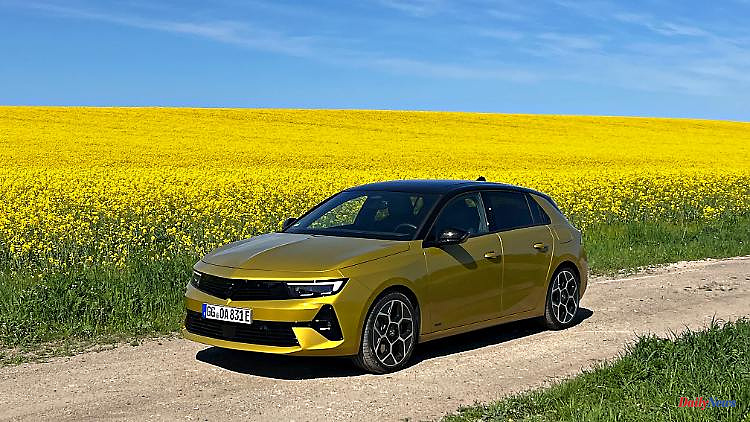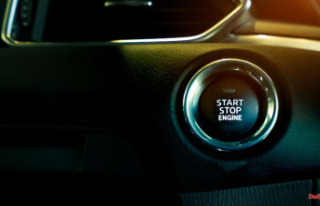The Astra is also one of the most important cars of the Rüsselsheim company under the umbrella of the Stellantis group. And like other manufacturers, Opel presents the plug-in hybrid as the top version of the compact. But can it convince on all points in the ntv.de practical test?
Before the discussion about plug-in hybrids and their obviousness escalated, VW summarily threw them out of the program. But maybe people in Wolfsburg just didn't feel like investing money in a technology that was already frowned upon before it was really up and running. But be that as it may, anyone who now wants a Golf with a double heart would have to sneak out. It is different with the eternal adversary, the Opel Astra. Thanks to French genes, the compact is also available as a plug-in hybrid. And that is offered by Opel as "top-of-the-line". Reason enough to call the part-time Stromer to the test.
With a system output of 180 hp and a maximum torque of 360 Newton meters, that doesn't sound all that powerful compared to other plug-in hybrids. It doesn't have to be, because what counts is what the driver gets. And that feels more. On the one hand, this is due to the really successful 1.6 liter petrol engine, which already provides 150 hp and the supporting 110 hp electric motor, which draws its power from a 12.4 kWh battery.
However, the hope for long emission-free journeys must be curbed at this point. Opel promises the magical 60 kilometers that are also necessary for federal funding. In real operation, however, one can be happy if it is 42 kilometers. And we're not talking about continuous fire and 135 km/h on the motorway, but about city traffic. Recuperation is simply not sufficient to return energy to the accumulator in a sustainable manner.
But the brakes are really annoying. Why? Because it simply cannot be dosed. In other words, you can't let them drag, for example to roll slowly to the intersection. At some point the jaws bite even though the foot hasn't moved a millimeter and then open just as unmotivated. As a result, the driver behind threatens to drive up because of the sudden stop, while the astonished Astra plug-in hybrid driver fears the next moment to be hanging on the bumper of the person in front. You have to learn to deal with this game of brakes. It works, but you definitely won't like it.
The same applies when using the adaptive distance radar in traffic jams. At the latest when the occupants, like the nodding dog on the rear shelf, have nodded wildly for the tenth time in stop-and-go, the annoyed driver switches the system off. Even in the flow of traffic, it's no fun. Here, the Astra darts towards the traffic ahead, only to then, like Lewis Hamilton, put on the irons before the sharp right-hand bend on a record time course. And since we're on the wizards. There is of course also an adaptive lane keeper. As with some other manufacturers, it has the bad habit of grabbing the steering wheel very badly if the driver only touches the median or shoulder. It gets really bad when it happens at 225 km/h.
Yes, the Rüsselsheimer is actually that fast. Incidentally, even without permanent electric motor support, because the battery is very quickly drained on the motorway. Which is not bad and speaks above all for the combustion engine. Even when driving briskly over long distances, fully loaded and with the additional weight from the battery and electric motor, it only consumes 7.7 liters. A really good value if you keep the digital speedometer number well above 200 on the open road. If you practice elegant restraint here, you can actually reduce consumption to under six liters, which all in all raises the question of how efficient the four-cylinder would be without the additional permanent weight?
Of course, the combustion engine recharges the battery while driving, of course the electric motor then supports spontaneous power demand and of course you can also charge the battery at the station. However, not on a fast charger, but only with up to 22 kW. It then takes two hours to reach 100 percent. No problem with the wall box at home, a tiresome process on the street, especially since the public charging points in the cities are very busy.
What distinguishes the Astra and again raises the question of whether it would not be the better choice without a second drive is its rather firm but not uncomfortable chassis, which harmonizes perfectly with the direct steering. The 8-speed automatic also does an excellent job. The really large head-up display also deserves praise, as it shows everything pin-sharp except for the traffic signs. Why the speed indications are not round, but much too small as an oval in the picture, is probably a secret of the manufacturer.
Incidentally, the dashboard is dominated by a large, curved, apparently continuous display along with integrated ventilation slots. It looks chic, although the two displays framed in it appear normal in size by current standards and the piano lacquer frame turns out to be an enormous dust collector in the course of the test.
As far as the adjustment of the central screen for the driver is concerned, you are limited. Actually there is only one setting. So if you would like to see digital round instruments, you will be disappointed, they don't exist. The only option is to put the navigation in the foreground with the button on the left steering column stalk and to change the levels of the on-board computer with the right steering column stalk. The center display can be used for all other settings via touch. The DAB radio is also tuned in, but this was noticed by the very poor reception. If you want to avoid this, it is better to connect your own smartphone via Bluetooth and use Apple CarPlay or Google Auto.
The seats with the predicate of the campaign for healthy backs are really great. In the test car, they were not only covered with nappa leather, but could also be air-conditioned and massaged the backs of the driver and front passenger with different programmes. In addition, everyone will find the right place on them, because not only can they be adjusted in length, height and inclination, the thigh support can also be lengthened or the side bolsters made narrower. And because that's not enough, there is an electro-pneumatic lumbar support that activates when the car is started.
It is also nice that Opel is not stingy with storage space in the Astra. There is a large compartment in the center armrest and a glasses compartment below the center air vents. In addition, the inner door compartments also swallow one liter PET bottles. The trunk volume ranges from 352 to 1268 liters. Part of the storage space in the test car was taken up by the universal charging cable, of which only one is needed on public sockets anyway. The space for travelers in the second row isn't exactly ample either. Although it has grown, although the Astra itself has shrunk to 4.37 meters, tall people will not enjoy staying there for long distances.
Conclusion: The Astra is definitely recommended as a family car. However, the interested party should find out whether they opt for the plug-in hybrid by taking a test drive with sufficient city traffic. Especially since the reflection period could be involuntarily extended anyway, because the PHEV cannot be ordered at the moment due to the delivery bottlenecks. But if it is possible, at least 38,650 euros should be kept ready. For the test car equipment, it is even 44,410 euros.
6












